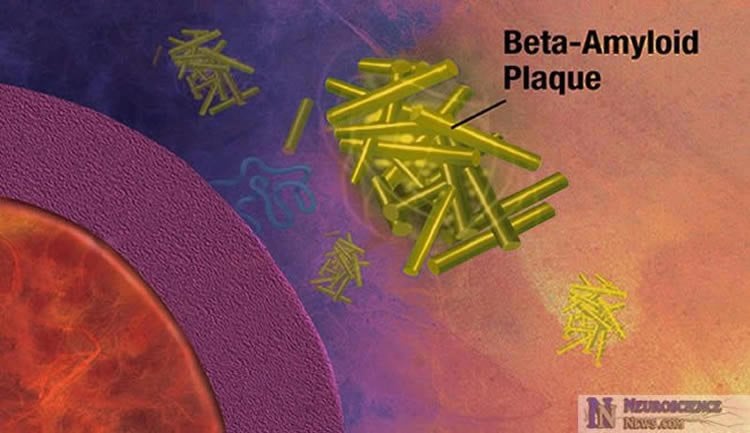Summary: Researchers report a drug which prevents blood clots and reduces the rfisk of heart attacks shows promise for the treatment of Alzheimer’s disease.
Source: Örebro University.
A new study from Örebro University, published in Science Signaling today, shows that heart medication reduces the build-up of plaque in the brain’s blood vessels in mice. The question is if this is true also in humans? If the answer is yes, it might bring scientists a step closer to developing a medicine against Alzheimer’s disease.
Together with German and Italian colleagues, the Örebro researchers have uncovered how a previously unknown mechanism is the cause of rapid build-up of plaque in blood vessels in the brain. Trials involving mice have therefore been performed to establish whether a specific heart drug is able to reduce plaque formation.
“You should be careful not to draw any major conclusions from experimental studies, but we have certainly identified an interesting approach worth taking further,” says Professor Magnus Grenegård at Örebro University, who together with Knut Fälker and Liza Ljungberg has been working on the study led by German Professor Margitta Elvers.
The study shows how the protein beta-amyloid sticks to the surface of blood platelets, also known as thrombocytes, initiating a rapid chain reaction. The result is an incredibly fast-paced build-up of plaque.
“Plaque causes nerve cells to die at too fast a rate, causing the symptoms indicative of Alzheimer’s disease, such as memory loss,” says Magnus Grenegård.
“Our study is an example of solid biomedical basic research at the cell and molecular levels which points to a link that was previously unknown. What is shown is that cells in the blood may play a significant role in the development of plaque, which is found in patients with Alzheimer’s disease.”
Researchers therefore tested a widely used heart drug which today is used to prevent blood clots and decrease the risk of a heart attack. The trials in mice showed that the lumps of protein, the plaque, were reduced when the rodents were treated with heart medication. The medication thus slows the process down. It is certainly true for the plaque in the blood vessels, but possibly also in the brain tissue itself.
“In deep structures of the brain, where certain memory functions are controlled, there was a clear trend of reduced plaque presence.”
“We do not know if this is transferrable to humans; if the effect would be the same. To find out, new follow-up studies are required. Unfortunately, this is a lengthy process – it will be years before we know. But at least we have identified a new, interesting approach with respect to plaque formation.”

Alzheimer’s disease is characterised by the damage of brain tissue. Early symptoms are a decline in memory and the ability to complete daily tasks, but ultimately the whole brain is affected.
“More than 100,000 Swedes have been diagnosed with Alzheimer’s disease and it brings great suffering to the patient, but also to family members. New medication would naturally be most welcome,” says Magnus Grenegård.
Source: Örebro University
Image Source: This NeuroscienceNews.com image is in the public domain.
Original Research: Abstract for “Platelets contribute to amyloid-β aggregation in cerebral vessels through integrin αIIbβ3–induced outside-in signaling and clusterin release” by Lili Donner, Knut Fälker, Lothar Gremer, Stefan Klinker, Giulia Pagani, Liza U. Ljungberg, Kimberley Lothmann, Federica Rizzi, Martin Schaller, Holger Gohlke, Dieter Willbold, Magnus Grenegard, and Margitta Elvers in Science Signaling. Published online May 24 2016 doi:10.1126/scisignal.aaf6240
[cbtabs][cbtab title=”MLA”]Örebro University. “Heart Medication Could Help Treat Alzheimer’s.” NeuroscienceNews. NeuroscienceNews, 25 May 2016.
<https://neurosciencenews.com/amyloid-heart-medication-alzheimers-4304/>.[/cbtab][cbtab title=”APA”]Örebro University. (2016, May 25). Heart Medication Could Help Treat Alzheimer’s. NeuroscienceNews. Retrieved May 25, 2016 from https://neurosciencenews.com/amyloid-heart-medication-alzheimers-4304/[/cbtab][cbtab title=”Chicago”]Örebro University. “Heart Medication Could Help Treat Alzheimer’s.” https://neurosciencenews.com/amyloid-heart-medication-alzheimers-4304/ (accessed May 25, 2016).[/cbtab][/cbtabs]
Abstract
Platelets contribute to amyloid-β aggregation in cerebral vessels through integrin αIIbβ3–induced outside-in signaling and clusterin release
Cerebral amyloid angiopathy (CAA) is a vascular dysfunction disorder characterized by deposits of amyloid-β (Aβ) in the walls of cerebral vessels. CAA and Aβ deposition in the brain parenchyma contribute to dementia and Alzheimer’s disease (AD). We investigated the contribution of platelets, which accumulate at vascular Aβ deposits, to CAA. We found that synthetic monomeric Aβ40 bound through its RHDS (Arg-His-Asp-Ser) sequence to integrin αIIbβ3, which is the receptor for the extracellular matrix protein fibrinogen, and stimulated the secretion of adenosine diphosphate (ADP) and the chaperone protein clusterin from platelets. Clusterin promoted the formation of fibrillar Aβ aggregates, and ADP acted through its receptors P2Y1 and P2Y12 on platelets to enhance integrin αIIbβ3 activation, further increasing the secretion of clusterin and Aβ40 binding to platelets. Platelets from patients with Glanzmann’s thrombasthenia, a bleeding disorder in which platelets have little or dysfunctional αIIbβ3, indicated that the abundance of this integrin dictated Aβ-induced clusterin release and platelet-induced Aβ aggregation. The antiplatelet agent clopidogrel, which irreversibly inhibits P2Y12, inhibited Aβ aggregation in platelet cultures; in transgenic AD model mice, this drug reduced the amount of clusterin in the circulation and the incidence of CAA. Our findings indicate that activated platelets directly contribute to CAA by promoting the formation of Aβ aggregates and that Aβ, in turn, activates platelets, creating a feed-forward loop. Thus, antiplatelet therapy may alleviate fibril formation in cerebral vessels of AD patients.
“Platelets contribute to amyloid-β aggregation in cerebral vessels through integrin αIIbβ3–induced outside-in signaling and clusterin release” by Lili Donner, Knut Fälker, Lothar Gremer, Stefan Klinker, Giulia Pagani, Liza U. Ljungberg, Kimberley Lothmann, Federica Rizzi, Martin Schaller, Holger Gohlke, Dieter Willbold, Magnus Grenegard, and Margitta Elvers in Science Signaling. Published online May 24 2016 doi:10.1126/scisignal.aaf6240






